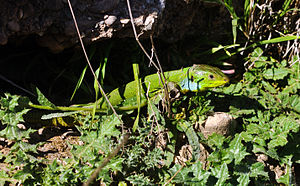Eastern giant emerald lizard
| Eastern giant green lizard | ||||||||||||
|---|---|---|---|---|---|---|---|---|---|---|---|---|

Eastern giant green lizard ( Lacerta media ) |
||||||||||||
| Systematics | ||||||||||||
|
||||||||||||
| Scientific name | ||||||||||||
| Lacerta media | ||||||||||||
| Lantz & Cyrén , 1920 |
The Eastern Giant Green Lizard ( Lacerta media ) is a large species of oriental lizard with a green basic color. Only with evidence of insufficient cross-ability and after further comparative genetic studies has it been recognized since around 1991 that it is a separate species besides the western green lizard ( Lacerta bilineata ). It has not yet been conclusively clarified whether the taxon can be called Lacerta viridis or Lacerta media .
features
The species reaches a head-trunk length of 12 to 14 cm. The top of the head is greenish or brownish, the remaining upper side of the adult males is completely green, the females have light vertical stripes. The tail is long, the rear end of the tail may be brown in color. Both sexes have bruises on the side of the neck, in the male they are also found on the side and on the base of the tail.
habitat
Green lizards prefer sun-warmed, south / south-west / south-east exposed slopes and a mixture of open structures and mosaic-like vegetation as habitat. For example, drier forest edges, semi-dry lawns (but not dry lawns without brush) and semi-open pastureland are particularly suitable. In green lizard habitats, there are often collections of stones with an accessible system of gaps (e.g. piles of stone piles and dry stone walls). The lizard occurs both in higher mountain regions ( Israel , Lebanon ) and in areas at sea level. On the Black Sea also in dune areas near the beach. The diurnal animals take extensive sunbaths in the morning and in the evening. In case of danger, they scurry very quickly into protective vegetation as well as crevices and hollows.
distribution
The species is found in Armenia and Azerbaijan, Georgia, Iran, Israel, Jordan, Lebanon, Syria, Turkey and Russia.
Subspecies
- Lacerta media ciliciensis Schmidtler, 1975
- Lacerta media isaurica Schmidtler, 1975
- Lacerta media israelica Peters, 1964
- Lacerta media media Lantz & Cyrén, 1920
- Lacerta media wolterstorffi Mertens, 1922
Individual evidence
- ↑ AmphReptil_Leseprobe from www.verlagsgemeinschaft.com at docs.google.com ( Memento of the original from March 4, 2016 in the Internet Archive ) Info: The archive link was inserted automatically and has not yet been checked. Please check the original and archive link according to the instructions and then remove this notice. (accessed November 25, 2009)
- ↑ Souad Hraoui-Bloquet, Riyad Sadek, Mona A. Sabeh: The male sexual cycle of Lacerta media Lantz and Cyren in Mount Lebanon compared with that of Lacerta laevis Gray. In: Bulletin de la Société Herpétologique de France. 4ème trimestre, No. 92, 1999, ISSN 0754-9962 , pp. 5-17, digitized .
Web links
- Lacerta media at www.iucnredlist.org (accessed November 25, 2009)
- Lacerta media in The Reptile Database